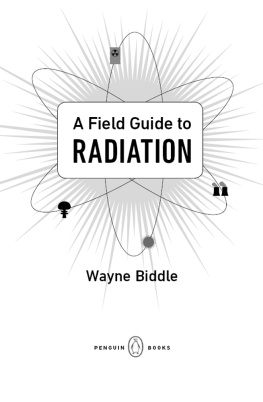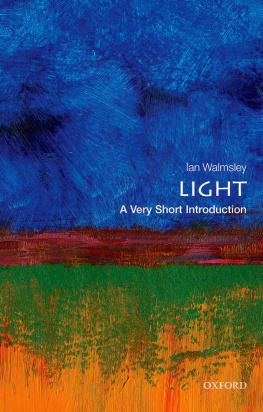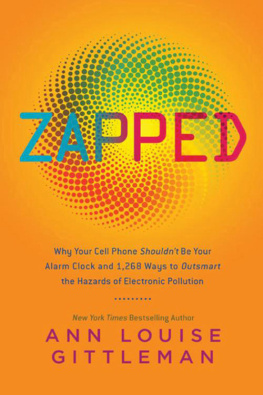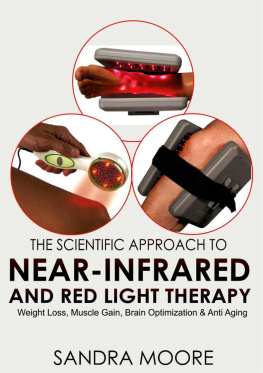I ts everywhere.
At this moment, as you sit quietly reading this book, you are awash in it. At work, its emanating from your electronic devices; step outside for lunch, and the sun bathes you in it. You may receive an extra dose of it when you visit your doctor, pass through security at the airport, or drive through city streets, but minuscule amounts of it are with you always. You cannot see, hear, smell, or feel it, but there is never a single second when it is not flying through your body. Too much of it will kill you, but without it you wouldnt live a year.
Invisible light seems like a contradiction. Like Simon and Garfunkels The Sound of Silence, its an oxymoron. We think of light, by definition, as something seen, something that enables our seeing, illuminating the darkness. Unlike dogs, who sniff in order to get what an object is, we depend on vision above all our other senses. We rely on light to tell us about our surroundings.
But just as there are frequencies of sound audible to other animals that we cannot hear, there is a whole world of light outside our range of vision, a world that is humming with activity. Though we rarely think about this invisible world, our way of life depends on it. Its because of invisible light that you can do things such as send a text message, use GPS to find your way to a friends house, listen to the radio, or microwave a frozen pizza. Invisible light shows us things we would never otherwise see, including our own skeletons and brains and the history of our universe.
I was reminded of just how much we rely on invisible light, and how mysterious it remains to us, during a visit from my sister and her family. It was a lazy summer afternoon, and we were sprawled across a few couches sharing a bowl of popcorn. My niece, her shoulders crimson after a day outdoors, was chatting on her cell phone, holding up a promising finger to her mother, who was scolding her for not using sunscreen. My brother-in-law, meanwhile, was asking my opinion on an article hed read proposing that Wi-Fi be banned in schools because of its dangers. We were all depending on invisible light (for the microwave popcorn, the cell-phone service) while being concerned that it might harm us (sunburn, mysterious Wi-Fi health threats) and confused about what to do to protect ourselves.
We need it, and it surrounds us, yet we remain uneasy about living with invisible light, partly because we fear what is unknown. After all, most of us dont know much about all the light we cannot see. This book aims to change that.
My hope is to expose the hidden side of the spectrum, to make the invisible (at least temporarily) visible and vivid to you. As youll see, each of the different varieties of invisible lightfrom gamma rays to infrared to ultraviolethas its own characteristics and peculiarities, as distinct as red is from blue. Well meet rays that pass through solid matter instead of being reflected by it and others that cause water to boil. Some come from deep space and zoom through astronauts brains; others are left over from the birth of the universe. You may be surprised to find how much of our world and our history is touched by invisible rays. They rescued lives when the Titanic went down. They help determine the daily weather. Some can produce sudden, lethally destructive damage in human bodies.
Well split our exploration into two equally important parts. In some chapters well go back in time to meet the pioneering scientists who first saw the invisible. Until the eighteenth century, no one had the faintest idea that there might be such a thing as light that cannot be detected by human vision, and until the nineteenth century no one had any proof of its existence. But once the discoveries of invisible light began, they avalanched, until most of todays indispensable aspects of life, the ones we take for granted, depend on them.
In other chapters well explore how these phantoms affect our lives and our bodies as they provide their near-magical conveniences, from the cell phone in your pocket to the radio in your car. What role does invisible light play in our medicine, our technology, and our culture in the twenty-first century? What new opportunities for its use are on the horizon?
Like my family lazing around the living room that summer afternoon, you probably have questions about how invisible light is affecting your health. What are the microwaves from your cell phone doing to your brain? What is radiation, and how much of it are you exposed to? Which invisible ray causes the most annual deaths? Which foods are most radioactive? This book will answer all those questions, clarifying once and for all the controversial claims about radiations health consequences. Some of the things youll learn will soothe you (ultraviolet light can decrease your risk of cancer), and some will shock you (a single whole-body CT scan delivers more radiation than was received by Hiroshima survivors a mile from ground zero), but in every case context is key. Myths will be busted, and wild facts will abound.
I f God really did say, Let there be light, it was no small housewarming present. There is a lot of light in the universeone billion photons of light for every subatomic particle. In terms of individual items in the cosmos, including the components of atoms, photons constitute 99.9999999 percent of everything. The universe is literally made of light. And that includes not only ordinary everyday visible light but also the vast majority of lightthe kind we cannot see.
Light is an astonishing entity, and the quest to understand it has obsessed the greatest thinkers in disparate cultures through the centuries. The ancient Greeks, probably by sheer dumb luck, were the first to hit upon a key aspect of visible lightthat it does not exist independent of us as observers. Physics now tells us that light is made up of intertwined magnetic and electrical fields. Since neither magnetism nor electricity is visible to our eyes,








